
About 80 percent of the global opioid supply is consumed by Americans. Tragically in 2016, an estimated 42,000 drug overdose deaths in the U.S. involved opioids, with most deaths attributed to prescription drugs.
That’s an average of 115 people dying every day. Final numbers for 2017 will be even higher.
The medical community is responding by curtailing opioid prescriptions for many conditions that would have been treated with opioids in the recent past. Understandably, many patients are concerned they won’t get the pain relief they need. But there are a number of alternatives to opioids for short-term, or acute pain, and even for long-term, or chronic pain.
Managing chronic pain is an involved and difficult process. No single treatment is suitable for everyone.
As medical practitioners, we tailor patients’ pain treatment plans to their specific illnesses or conditions and determine if opioids might be appropriate.
Opioids are uniquely effective for some conditions. Notably, opioids help patients reduce chronic pain related to cancer. In addition, post-surgical patients with acute pain might be prescribed a short course of opioids.
In my practice, I see patients with multiple rib fractures who need pain control for maximum respiratory effort to prevent pneumonia. An opioid is sometimes the best pain relief I can provide them.
Keep in mind, though, that while opioids may temporarily alleviate pain, they don’t treat the condition causing the pain. So, any opioid should generally be accompanied by treatment for the disease (e.g., a medication for rheumatoid arthritis or one for neuropathy).
Increasingly, physicians are recommending viable alternatives to opioids.
The most common options for providing pain relief include:
- Non-opioid medications by prescription
- Non-opioid medications without prescription (also known as over-the-counter)
- Non-drug treatments: physical therapy, exercise, rehabilitation therapy and more
Opioids should usually be prescribed only when nothing else works. Effective non-opioid medications are available to alleviate chronic pain.
For example, my patient with chronic knee pain will likely get more relief from an anti-inflammatory drug, along with physical therapy, than from an opioid.
In patients newly diagnosed with chronic pain, non-opioid medications should always be considered before opioids.
Non-opioids rarely contribute to patients developing drug use disorders. According to the Centers for Disease Control and Prevention (CDC), “The number of fatal overdoses associated with non-opioid medications is a fraction of those associated with opioid medications.”
As physicians, when we prescribe opioids, we generally combine them with non-opioid medications and non-drug treatment. In fact, the CDC recommends non-opioid medications and non-drug treatment as the preferred therapies for chronic pain.
Research shows the most successful non-drug treatments to be physical therapy, exercise and rehabilitation therapy. Other effective options I might recommend for patients are strength training, yoga, heat or cold therapy, ultrasound, acupuncture and transcutaneous (through-the-skin) electrical stimulation.
I also want to emphasize the value of non-prescription pain-relievers, which can work as well as opioids for short-term pain, like that from broken bones, dental work or kidney stones.
A recent clinical trial studied the effects of opioids vs. non-prescription pain-killers on chronic back pain or osteoarthritis pain in hips or knees. Some patients took opioids (morphine, oxycodone or hydrocodone), while others took acetaminophen (Tylenol) or ibuprofen (Advil, Motrin).
After a year, treatment with opioids was no more effective than with non-prescription pain-killers. The researchers concluded that opioid therapy wasn’t warranted for chronic back pain or hip or knee osteoarthritis pain.
Another study, this one with emergency room patients, showed that acetaminophen and ibuprofen combined can be as effective as the opioid Percocet.
But even non-prescription medications should be taken only when pain is moderate or severe, not mild.
New research shows some Americans taking too many over-the-counter pain relievers, too, such as aspirin, Advil, Motrin and Aleve. Misuse of non-prescription drugs could lead to complications, including gastrointestinal bleeding and heart attack.
Although current evidence is lacking to show effectiveness for reducing chronic pain, some of my patients have found significant relief when using medical marijuana, in combination with other treatments above. As an emerging treatment for chronic pain, medical marijuana has two components that may be effective: tetrahedrocannabinol (THC) and cannabidiol.
With all that we try to do to curb the epidemic, there will always be more. For example, we need to be better about instructing patients to always take any medication exactly as prescribed. This is a collective effort that involves pharmacists as well. We need to be sure that a patient knows to not take more pills than directed, or more often. If they can stop using opioids because they are pain-free, we need to tell them how to dispose of them safely. Many times, patients keep them and use them later — for a headache, leg cramp, etc. — or give them to family members or friends, which can lead down a dangerous path to addiction.
If our patient feels they are addicted to opioids, they need to feel like they can speak with us. We need to help change the stigma around addiction and view addiction as the disease it is — as we do cancer, heart disease or arthritis. Recognizing this can be the first step toward recovery for patients and their loved ones.
Jordan Klein, MD is a Physical Medicine & Rehabilitation physician specializing in alternatives to opioid for pain control, trauma, brain injury and spinal cord injury. He has established a trauma physiatry service at Geisinger Holy Spirit, inpatient rehab at HealthSouth Mechanicsburg and integrated a continuity of care model from acute care hospital to home.







